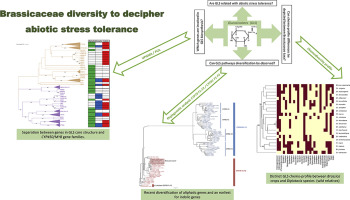Plant Physiology and Biochemistry ( IF 6.1 ) Pub Date : 2020-02-26 , DOI: 10.1016/j.plaphy.2020.02.032 Anyse Pereira Essoh 1 , Filipa Monteiro 2 , Ana Rita Pena 3 , M Salomé Pais 4 , Mónica Moura 5 , Maria Manuel Romeiras 6

|
Brassica is one of the most economically important genus of the Brassicaceae family, encompassing several key crops like Brassica napus (cabbage) and broccoli (Brassica oleraceae var. italica). This family is well known for their high content of characteristic secondary metabolites such as glucosinolates (GLS) compounds, recognize for their beneficial health properties and role in plants defense. In this work, we have looked through gene clusters involved in the biosynthesis of GLS, by combining genomic analysis with biochemical pathways and chemical diversity assessment. A total of 101 Brassicaceae genes involved in GLS biosynthesis were identified, using a multi-database approach. Through a UPGMA and PCA analysis on the 101 GLS genes recorded, revealed a separation between the genes mainly involved in GLS core structure synthesis and genes belonging to the CYP450s and MYBs gene families. After, a detailed phylogenetic analysis was conducted to better understand the disjunction of the aliphatic and indolic genes, by focusing on CYP79F1–F2 and CYP81F1–F4, respectively. Our results point to a recent diversification of the aliphatic CYP79F1 and F2 genes in Brassica crops, while for indolic genes an earliest diversification is observed for CYP81F1–F4 genes. Chemical diversity revealed that Brassica crops have distinct GLS chemo-profiles from other Brassicaceae genera; being highlighted the high contents of GLS found among the Diplotaxis species. Also, we have explored GLS-rich species as a new source of taxa with great agronomic potential, particularly in abiotic stress tolerance, namely Diplotaxis, the closest wild relatives of Brassica crops.
中文翻译:

探索十字花科中的芥子油苷多样性:破译非生物胁迫耐受性的基因组和化学评估。
甘蓝是十字花科经济最重要的属之一,包含几个关键作物,如油菜(甘蓝)和西兰花(甘蓝oleraceae变种斜体一种)。该家族以高含量的特征性次级代谢产物(如芥子油苷(GLS)化合物)而闻名,以其有益的健康特性和在植物防御中的作用而广为人知。在这项工作中,我们通过将基因组分析与生化途径和化学多样性评估相结合,研究了参与GLS生物合成的基因簇。使用多数据库方法,共鉴定了101个参与GLS生物合成的十字花科基因。通过UPGMA和PCA分析记录的101个GLS基因,发现主要参与GLS核心结构合成的基因与属于CYP450 s和MYB的基因之间存在分离的基因家族。此后,进行了详细的系统发育分析,以更好地了解脂族和吲哚基因的分离,分别关注CYP79F1-F2和CYP81F1-F4。我们的研究结果表明,甘蓝型油菜作物中的脂肪族CYP79F1和F2基因最近出现了多样化,而对于靛蓝基因,CYP81F1-F4基因出现了最早的多样化。化学多样性表明,芸苔属作物具有不同于其他芸苔属的GLS化学特征。强调了在Diplotaxis中发现的GLS的高含量种类。此外,我们还探索了富含GLS的物种作为具有巨大农艺潜力的新分类单元的来源,特别是在非生物胁迫耐受性方面,即Diplotaxis,这是芸苔属作物的最接近野生近缘种。











































 京公网安备 11010802027423号
京公网安备 11010802027423号